 The HP DL360p Gen8 is a leading 1U server designed to support the needs of both large data centers that require the compute density that this versatile server offers as well as small and medium sized businesses that appreciate and want to leverage the value and reliability the Gen8 server platform. While the DL360p has been very recently replaced with the DL360 Gen9, those looking for excellent enterprise value without the need for the highest-end computer power will find good value in the HP Gen8 servers as well as its enhanced serviceability and configuration flexibility.
The HP DL360p Gen8 is a leading 1U server designed to support the needs of both large data centers that require the compute density that this versatile server offers as well as small and medium sized businesses that appreciate and want to leverage the value and reliability the Gen8 server platform. While the DL360p has been very recently replaced with the DL360 Gen9, those looking for excellent enterprise value without the need for the highest-end computer power will find good value in the HP Gen8 servers as well as its enhanced serviceability and configuration flexibility.
The HP DL360p Gen8 is a leading 1U server designed to support the needs of both large data centers that require the compute density that this versatile server offers as well as small and medium sized businesses that appreciate and want to leverage the value and reliability the Gen8 server platform. While the DL360p has been very recently replaced with the DL360 Gen9, those looking for excellent enterprise value without the need for the highest-end computer power will find good value in the HP Gen8 servers as well as its enhanced serviceability and configuration flexibility.
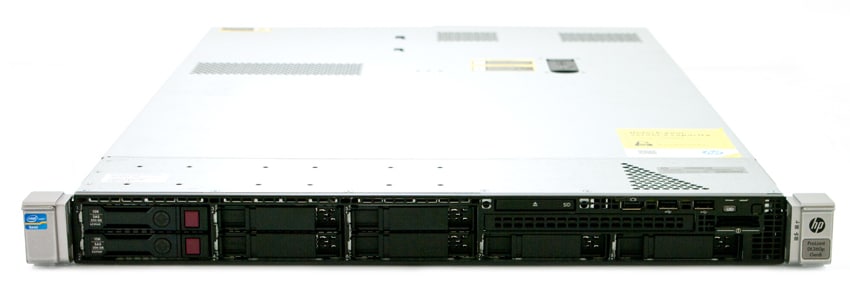
As far as its hardware goes, the HP ProLiant DL360p Gen8 Server series is comprised of 1U, 2-socket configurations that feature a Smart Array P420i RAID controller with up to 2GB Flash Backed Write Cache (FBWC), up to two Intel E5-2600v2 or E5-2600 Series processors, two PCIe 3.0 expansion slots, and feature-rich, built-in management capabilities. Our server accepts small form factor (SFF) 2.5-inch SAS, SATA, or SSD drives, while other configurations of the ProLiant DL380p Gen8 servers accepting large form factor (LFF) 3.5-inch drives are also available. Its Intel Xeon processor E5-2600 allows the DL360p to produce maximum performance, memory, I/O connectivity and bandwidth for some pretty demanding workloads.
We will be using the ProLiant DL360p Gen8 Server in our StorageReview labs to test small NAS devices that include enough power and support for flash storage. Small NAS are increasingly finding their way into the enterprise for applications like small databases, be it in production, internal use or in a test/dev scenario. To that end, the Gen8 works perfectly, pairing HP's reliability and support with a slightly older configuration that does not need to be the latest and greatest from a compute power perspective.
This build is comprised dual Intel E5-2687 v2 processors, 64GB RAM (8x8GB), two 300GB 15K SAS HDDs for boot (RAID1), HP Ethernet 1Gb 4-port 331FLR Adapter, and a HP Smart Array P420i/1GB with FBWC storage controller (RAID0/1/1+0/5/5+0/6/6+0). To make a suitable testbed for this role, we added a 10G Ethernet card and IB card (both of which are non-HP components).
System features
- Processor family: Intel Xeon E5-2600 v2 product family
- Chipset:
- Intel C600 Series Chipset
- Intel E5-2600 Processor Family
- Intel E5-2600 v2 Processor Family
- Number of processors: 2 or 1
- Processor core available: 12 or 10 or 8 or 4
- Form factor (fully configured): 1U
- Power supply type: (2) Common Slot
- Expansion slots: (2) Maximum
- 1 PCIe 3.0 x8, Low profile slot, Activated when installed with processor 1
- 1 PCIe 3.0 x16, Full-height, half-length slot, Activated when installed with processor 1
- Cache Memory:
- 30MB (1x30MB) Level 3, For Twelve-core processors
- 25MB (1x25MB) Level 3, For Ten-core processors
- 20MB (1x20MB) Level 3, For Eight-core processors
- 15MB (1x15MB) Level 3, For Six-core processors
- 10MB (1x10MB) Level 3, For Quad-core processors
- 5MB (1x5MB) Level 3, For Dual-core processors
- Memory, maximum: 768GB
- Memory slots: 24 (12 DIMM slots per processor /4 channels per processor/3 DIMMs per channel)
- Memory type:
- Maximum Capacity (LRDIMM): 768GB (24 x 32GB@1066MHz)
- Maximum Capacity (RDIMM): 384GB (24 x 16GB@1333MHz)
- Maximum Capacity (UDIMM): 128GB (16 x 8GB@1333MHz)
- Maximum Capacity (HDIMM): 384GB (24 x 16GB@1333MHz)
- Graphics
- Integrated Matrox G200 video standard
- 1280 x 1024 (32bpp)
- 1920 x 1200 (16bpp)
- HP iLO 4 On System Management Memory
- 16MB Flash
- 256MB DDR3 with ECC (112MB after ECC and video)
- Integrated Matrox G200 video standard
- Storage: (4) LFF SAS/SATA/SSD or; (10) SFF SAS/SATA/SSD or; (8) SFF SAS/SATA/SSD; Hot plug, depending on model
- Controller Cards
- Network controller: (1) 1Gb 331FLR Ethernet Adapter 4 Ports per controller or; (1) 10Gb 530FLR-SFP+ Ethernet Adapter 2 Ports per controller; Depending on model
- Storage controller:
- Entry Models: HP Smart Array P420i/ZM (RAID0/1/1+0)
- Base Models: HP Smart Array P420i/1GB with FBWC (RAID0/1/1+0/5/5+0/6/6+0)
- Performance Models: HP Smart Array P420i/2GB with FBWC (RAID0/1/1+0/5/5+0/6/6+0)
- Energy Star Models (One of the following depending on Model):
- HP Smart Array P420i/1GB FBWC (RAID0/1/1+0/5/5+0/6/6+0)
- HP Smart Array P420i/ZM (RAID0/1/1+0)
- Maximum Internal Storage:
- Hot Plug SFF SAS, 12.0TB, 10x 1.2TB
- Hot Plug SFF SATA, 10.0TB, 10x 1TB
- Hot Plug LFF SAS, 12.0TB, 4x 3TB (with optional LFF drive cage)
- Hot Plug LFF SATA, 16.0TB, 4x 4TB (with optional LFF drive cage)
- Hot Plug SFF SAS SSD, 8.0TB, 10x 800GB
- Hot Plug SFF SATA SSD, 4.0TB, 10x 400GB
- Hot Plug LFF SATA SSD, 3.2TB, 4x 800GB (with optional LFF drive cage)
- System Fans
- One of the following depending on Model:
- 6 fan modules ship standard in 1 processor models
- 8 fan modules ship standard in 2 processor models
- One of the following depending on Model:
-
Dimensions and weight:
- Dimensions (W x D x H): 43.45cm x 62.23cm x 2.97cm
- Weight: 17.4kg
- Server management:
- Infrastructure management
- iLO Management Engine, Insight Control; iLO Management Engine, Insight Control (optional)
Design and build
The sliding-rack and cable management arm allows DL360p to be serviced by sliding it out of the rack, which works seamlessly and without disconnecting any cables from the server. A more barebones version of the DL360p can be purchased without rails, or with a basic non-sliding friction mount.

The front panel of the DL360p is equipped with 2x USB ports and a VGA connector, the latter of which requires a Front Video Adapter Kit. Our unit features eight 2.5" SFF drive bays. There is also a slot for an optional optical drive to the left of the hot plug bays. The slide-out System Insight Display (SID) provides users with useful information so they can diagnose server failures or to ensure that everything is running well. If there are currently no failures, the system health is normal and LEDs will be green. If a failure does occur and a redundant feature has enabled the system to continue running, the LED will appear as amber. If a critical failure occurs and causes shutdown, the LED shows red. The two NIC 1 link/activity LED display the network status; green light and indicates that the network link exists whereas no light shows that the network does not exist. If the issue is serviceable without having to open the enclosure’s hood, the External Health LED will illuminate. However, if the hood must be removed then the Internal Health LED illuminates. Note that depending on the model, you may or may not have this LED.
HP has jam-packed the DL360p server with useful features for many of its components and hardware. For example, the drive tray includes handy LED indicators: the rotating LED, where green tells users that there is drive activity, while off means no activity; the Locate LED, where solid blue means the drive is being identified by a host application, while flashing blue means firmware is being updated or requires and update; the do not remove LED, where solid white means removing the drive may cause logical drives to fail, while off means it is safe to remove. The drive status LED also gives users a plethora of information. Though it may seem a bit overwhelming when drives flashing all kinds of different lights, it’s very straightforward on how to interpret what exactly is going on. HP is really keen on users being able to specifically diagnosing whatever might be going on within the server.
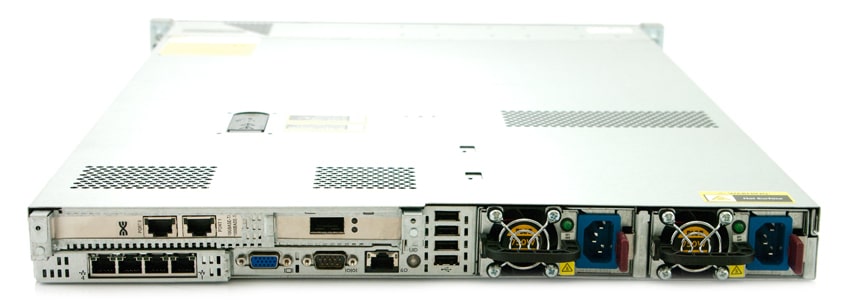
The rear panel also has various connections for user convenience, including the VGA and two USB ports (though both VGA ports can't be used simultaneously). Other ports include a serial interface, legacy keyboard and mouse connectors, NIC ports, and the iLO 2/NIC connector.
Under the hood shows a great level of detail and intelligent design, with a great focus to easy serviceability when designed the DP360 Gen8 server as well as putting as much as they can inside its 1U form-factor. It has minimal amount of cabling inside the chassis due to HP routing many of the basic features on the motherboard itself, including its front-mount storage cabling.
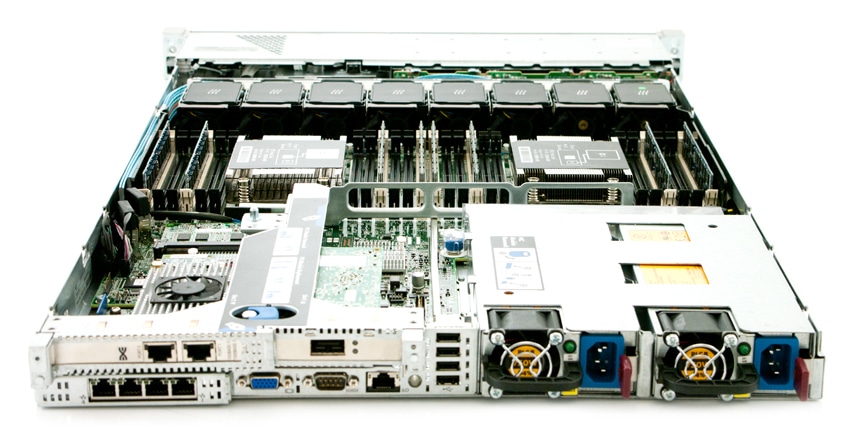
Upgrading, replacing, and installing new hardware and components is very easy due to its tool-less design; you’ll never have to take out your screw driver or other tools to install most components including fans, DRAM or PCIe adapters. In addition, HP provides a full hardware diagram on the inside of the system cover for easy component identification.
Keeping a server cool is one of the more important issues that always need to be managed. As such, all fans inside the HP DL360p are held in with quick-connects, and can be replaced by removing the top lid effortlessly. HP went the extra mile to ensure that a an intelligent cooling design was used in the build opposed to the “brute force” cooling method that consists of high-speed fans to blow through unnecessary cables that have the ability to cause issues with efficiency and air circulation.
The DL360p provides ample airflow to everything inside the server chassis, which ensures that all components are kept as cool as possible. It also includes 3D array of temperature sensors, which helps to accurately control server fans and direct cooling while reducing unnecessary fan noise and power consumption, potentially saving on cooling costs. In addition, users can change the amount of cooling needed via the BIOS and, if need be, override all automatic cooling options to force its max airflow.
Management
HP iLO Management Engine is a complete set of embedded features and easy-to-use integrated management and support, which comes standard on all ProLiant Gen8 servers. Some of these features include HP iLO, HP Agentless Management, HP Active Health System, HP Intelligent Provisioning, and HP Embedded Remote Support.
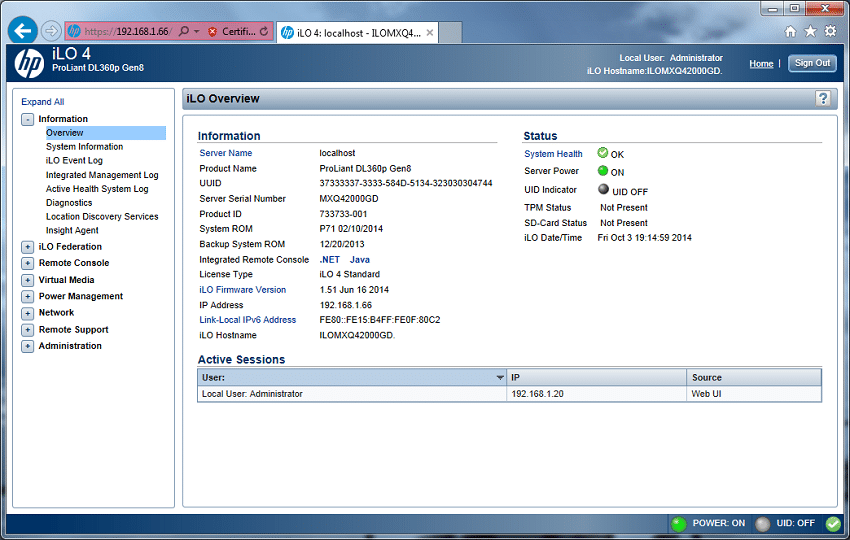
HP Active Health System is an important component of the HP iLO Management Engine, providing continuous, proactive health monitoring of over 1600 system parameters. Every single configuration change made by a user is logged for more accurate problem resolution, which lessens time with reproducing or describing errors. It does all this while having no impact on the system’s performance. All information that is gathered by Active Health is logged securely, isolated from the operating system, and separate from any customer data. Users can securely export the Active Health file to an HP Support professional within minutes, to help resolve issues efficiently.
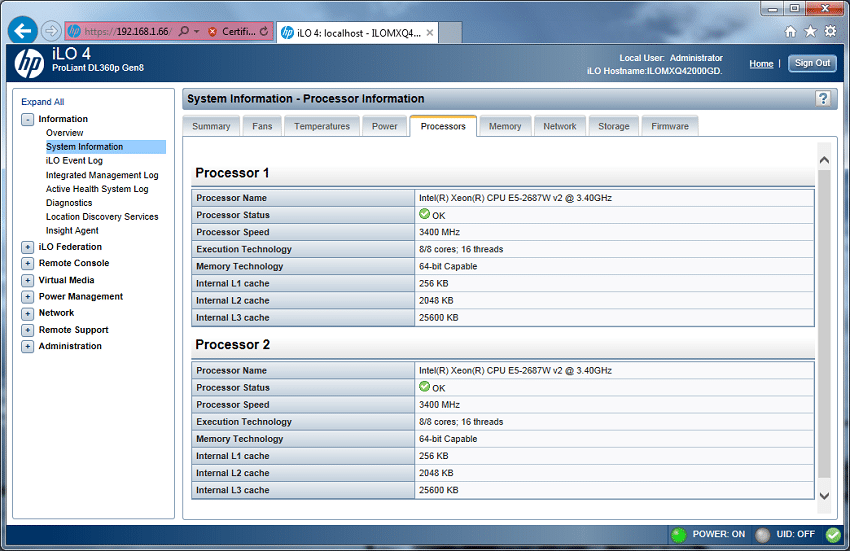
HP Agentless Management offers core management functions for internal system components, including health monitoring and alerts directly from iLO; all without any drivers or agents installed. This functionality is seamless to configure and will work no matter what the OS is or its current state, supporting the following subsystems: CPUs, memory, temperature sensors, fans, power supplies, SmartArray controllers (including cache modules) and both Logical and Physical Drives (internal to the server) that are connected to the SmartArray controller. Users simply just plug in the iLO network cable and power cord and the server will be inherently manageable using iLO, monitoring the health of the server with SNMP alerts.
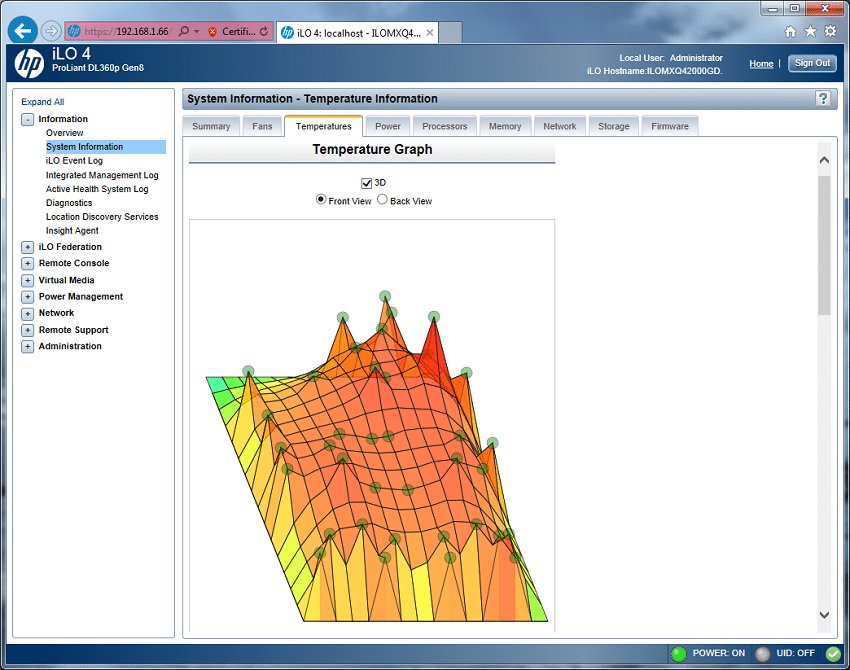
HP provides a server-provisioning tool that accelerates getting servers deployed quickly and inexpensively with Intelligent Provisioning. All required drivers and software tools are pre-loaded onto the HP ProLiant DL360p Gen8 Server, eliminating the need to searching for drivers online or loading from discs. Users simply press the F10 key during a server boot to get started and it recognizes if system software is out-of-date and will automatically download the latest version directly from the Internet.
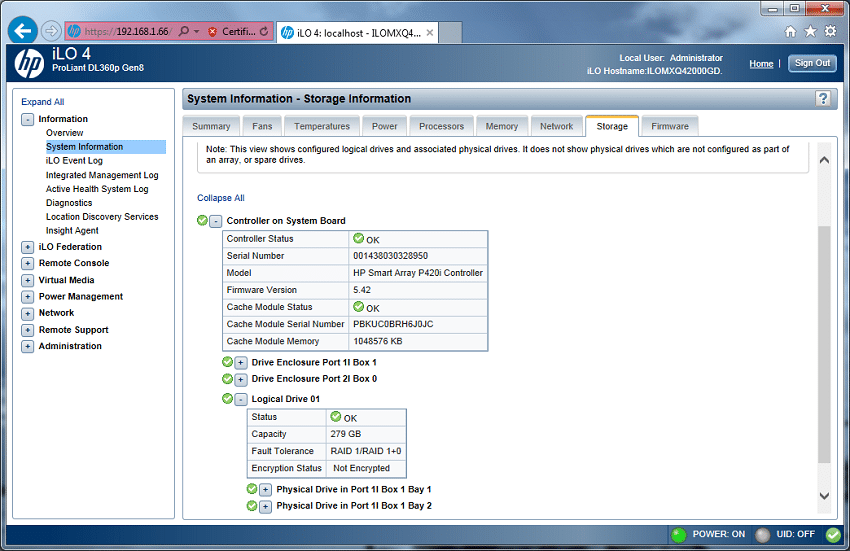
Also included are various other tools to manage the infrastructure including, HP Insight Control, which offers users even more advanced management capabilities HP ProLiant DL360p Gen8 Server’s infrastructure. HP Insight Online with HP remote support provides 24 hours/7 days a week remote monitoring as well as personalized access to your IT and support status at any time and any place. With HP SmartUpdate, deployment time and update complexity are reduced by systematically updating server infrastructure in the data center.
The HP Smart Storage Administrator (SSA) management and configuration application offers users with a single interface for HP Smart Storage products and solutions that quickly sets up, configures and manages the HP Smart Arrays controllers as well as the HP SAS Host Bus Adapters. HP SSA also allows users to configure the cryptographic features of HP Secure Encryption (which is a controller-based data encryption solution for HP ProLiant Gen8 servers to protect idle data on any bulk storage attached to the HP Smart Array Px3x controller), enable HP SSD Smart Path and create different optimization and priorities associated with the drives and controllers. In addition, SSA can be deployed to one server or multiple servers in user environments and has SSA scripting capability for customizable configuration that can be deployed to multiple servers at once.
It has being specifically updated for HP ProLiant servers to enhance and improve the storage experience and will be constantly updated with new features and functionalities for various Smart Storage initiatives as they released.
Hardware options
The HP DL360p Gen8 series can be configured with up to two Intel Xeon E5-2600 family processors and up to two PCIe 3.0 I/O slots for additional communications and storage expansion. The base configuration per CPU includes one Full-Height/Half-Length x16 PCIe 3.0 slot and one low-profile x8 PCIe 3.0 slot. HP offers different configurations as well as upgradeability, including a redundant power supply, and a FlexibleLOM slot for 1Gigabit or 10 Gigabit Ethernet or QDR/FDR InfiniBand networking options.
Each Intel Xeon E5-2600 processor socket contains four memory channels that support three DIMMs each for a total of 12 DIMMs per installed, which totals up to 24 DIMMs per server for businesses that require higher memory capacity. The ProLiant DL360p Gen8 also supports HP SmartMemory (which is needed to realize the memory performance improvements and enhanced functionality) RDIMMs, UDIMMs, and LRDIMMs up to 768GB (24 x 32GB@1066MHz).
The HP ProLiant DL360p Gen8 is equipped with a dedicated iLO port as well as the iLO Management Engine, which consists of Intelligent Provisioning, Agentless Management, Active Health System, and embedded Remote Support as previously discussed.
Application Workload Analysis
In order to understand the performance characteristics of enterprise storage devices, it is essential to model the infrastructure and the application workloads found in live production environments. To further drive this level of analysis into SMB NAS storage systems, HP provided StorageReview with this DL360p Gen8 server configuration for generating load for SQL Server tests with NAS storage targets. While our larger-scale tests use a 3,000 scale TPC-C database (about 685GB) our virtualized environment for smaller NAS arrays tests 250 and 500 scale databases (57GB and 112GB).
HP DL360p Gen8 Virtualized SQL Server Configuration
- 2x Intel Xeon E5-2687 v2 (3.4GHz, 20MB Cache, 8-cores)
- Memory – 64GB (8 x 8GB) 1333Mhz DDR3 Registered RDIMMs
- Hypervisor: VMware ESXi 5.1
- Guest OS: Windows Server 2012
- Boot storage:
- HP Smart Array P420i/1GB
- (2) 300GB 15K SAS HDD in RAID1
- Emulex OneConnect OCe11102-NT 10GBase-T (10GbE RJ45) PCIe 2.0 Dual-Port HBA
- HP Ethernet 1Gb 4-port 331FLR Adapter
- Mellanox ConnectX-3 InfiniBand Adapter Single-Port
Netgear ProSafe GS752TXS Smart 52-port Switch
- 48 1GbE Ports, 4 10GbE SFP+ Uplink Ports
- 176Gb/s Aggregate Bandwidth
- 8 3.5" HDD/SSD bays
- 4x 1GbE Network Connectivity
StorageReview’s Microsoft SQL Server OLTP testing protocol employs the current draft of the Transaction Processing Performance Council’s Benchmark C (TPC-C), an online transaction processing benchmark that simulates the activities found in complex application environments. The TPC-C benchmark comes closer than synthetic performance benchmarks to gauging the performance strengths and bottlenecks of storage infrastructure in database environments. For the following benchmarks, which measure a workload of 2.5K and 5K virtual users (VUs), we outfitted a Synology DS1813+ with either 8 HDDs in RAID10 or 2 SSDs in RAID1.
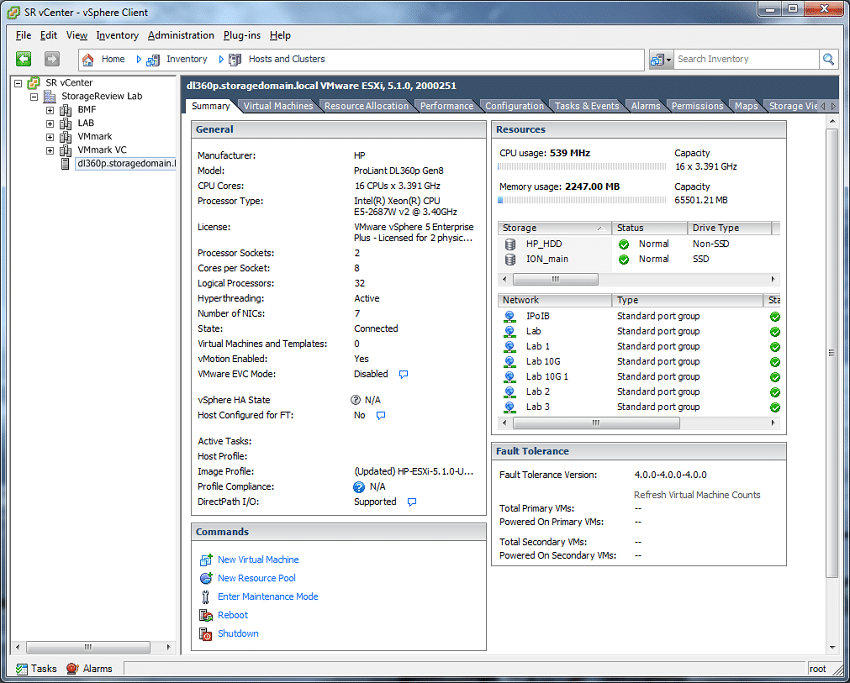
In our SQL Server test with 2.5K VUs, the Synology 1813+ HDD configurations posted similar results with its HGST NAS 4TB (522.5TPS), WD Pro Red Pro 4TB (519.3TPS), WD Red 6TB (518.6TPS), and WD Se 4TB (502.2TPS) 8x drive setup. The Seagate 6TB drive posted 524 TPS.
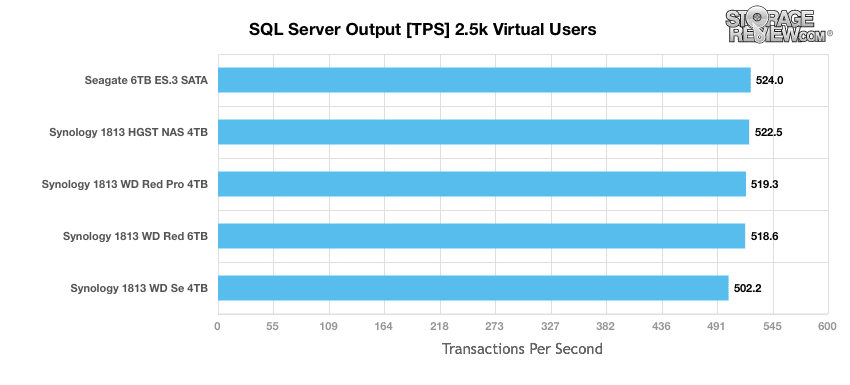
When looking at average latency under the same VU server workload, the Seagate 6TB ES.3 boasted an impressive 26ms. The HGST drives showed an overall latency of 41ms, while the WD Red Pro, WD Red, and WD Se configurations posted 72ms, 79ms, and 238ms, respectively.
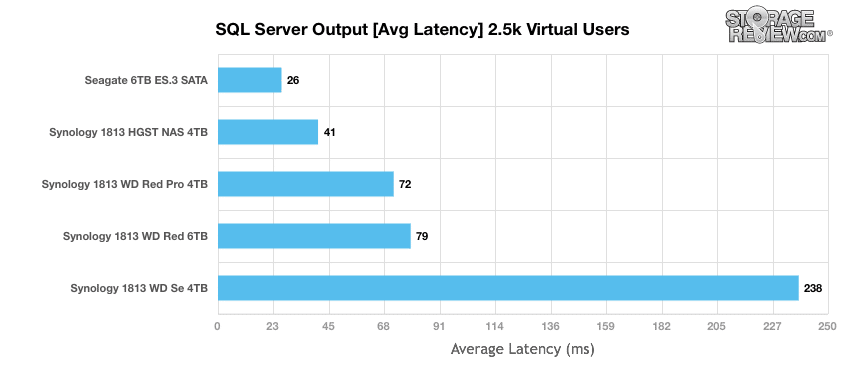
When moving to our 5K VU server workload, we added 2x Samsung 845DC and 2x Micron M500DC SSD configurations (in RAID1) to our benchmark tests. Here, the Samsung and Micron SSDs posted an identical TPS of 1050.8 through the Synology 1813+. Our HGST, WD Red, WD Red Pro and WD Se HDD configurations recorded 1028.1TPS, 1019.2TPS, 981.6TPS, and 945.2TPS, respectively, while the Seagate drive boasted a TPS of 1031.7.
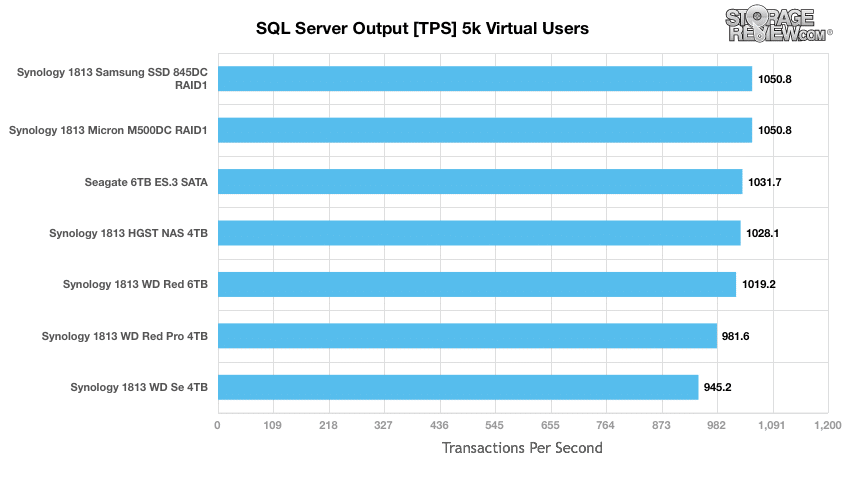
When looking at the overall latency performance of the same VU server workload, the Samsung and Micron SSD configurations showed 14ms and 15ms, respectively. Our Synology DS1813+ HDD configurations showed an average latency of 121ms for the HGST, 163ms for the WD Red, 354ms for the WD Red Pro, and 549ms for the WD Se, while the Seagate 6TB drive showed 105ms.
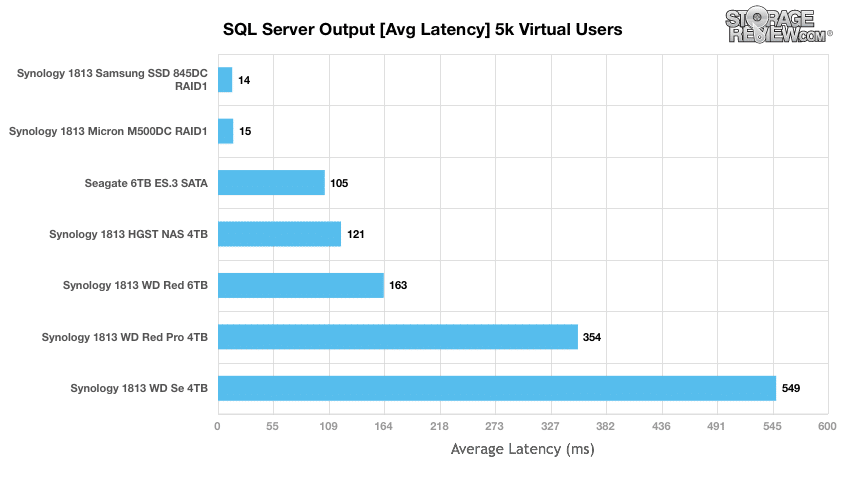
Conclusion
The HP ProLiant DL360p Gen8 Server is designed for large data centers that demand extensive compute density in addition to small and medium sized businesses that are looking to take advantage of the value, flexibility, and reliability of HP's Gen8 server platform. This versatile server also offers their iLO Management Engine as well as other server innovations, which provide integrated management and support to help make server coordination incredibly easy. Like its successor, HP leverages core advancements in technology inside the DL360p, such as with a Smart Array P420i RAID controller that supports up to 2GB FBWC, up to two Intel E5-2600v2 or E5-2600 Series processors, and two PCIe 3.0 expansion slots. The Intel Xeon processor E5-2600 allows the DL360p to produce some pretty good performance, I/O connectivity, and bandwidth for tough workloads.
It's also quite evident that HP has put a focus on server temperature, as they have designed the DL360p to be a much better system than its predecessors as far as thermal design goes. HP has implemented an intelligent cooling design rather than using high-speed fans that blow air through superfluous cables, which can cause issues with efficiency and air circulation. We also found that the fans inside the DL360p (which uses the “quick-connect” functionality to secure into place) easy to install and its 3D array of temperature sensors accurately controlled its speed and direction, which reduced quite a bit of fan noise.
Turning to its use in our lab, we leverage the DL360p to drive database loads hosted on shared storage in small-scale SQL Server test. Using the Synology DS1813+ to present iSCSI LUNs to our SQL VM we measured average latency across a number of popular HDD and SSD combinations. We saw tremendous performance, as well as the potential for very low latency results utilizing SSDs. With plenty of onboard storage and networking options, as well as good expansion capabilities in its 1U form-factor, the DL360p Gen8 makes for a capable platform for mainstream application needs.
Pros
- Hardened platform
- Complete server management suite
- Great on-board networking options
Cons
- Support contract required for long-term non-critical software/BIOS updates
Bottom Line
The HP ProLiant DL360p Gen8 is a high-density compute platform that's a great fit when reliability and cost take precedence over the latest and greatest technology. Even two plus years after initial launch, the DL360p stands out as a hardened enterprise server that works equally well for SMBs and large-scale datacenters.
HP ProLiant DL 360p Gen8 Product Page
